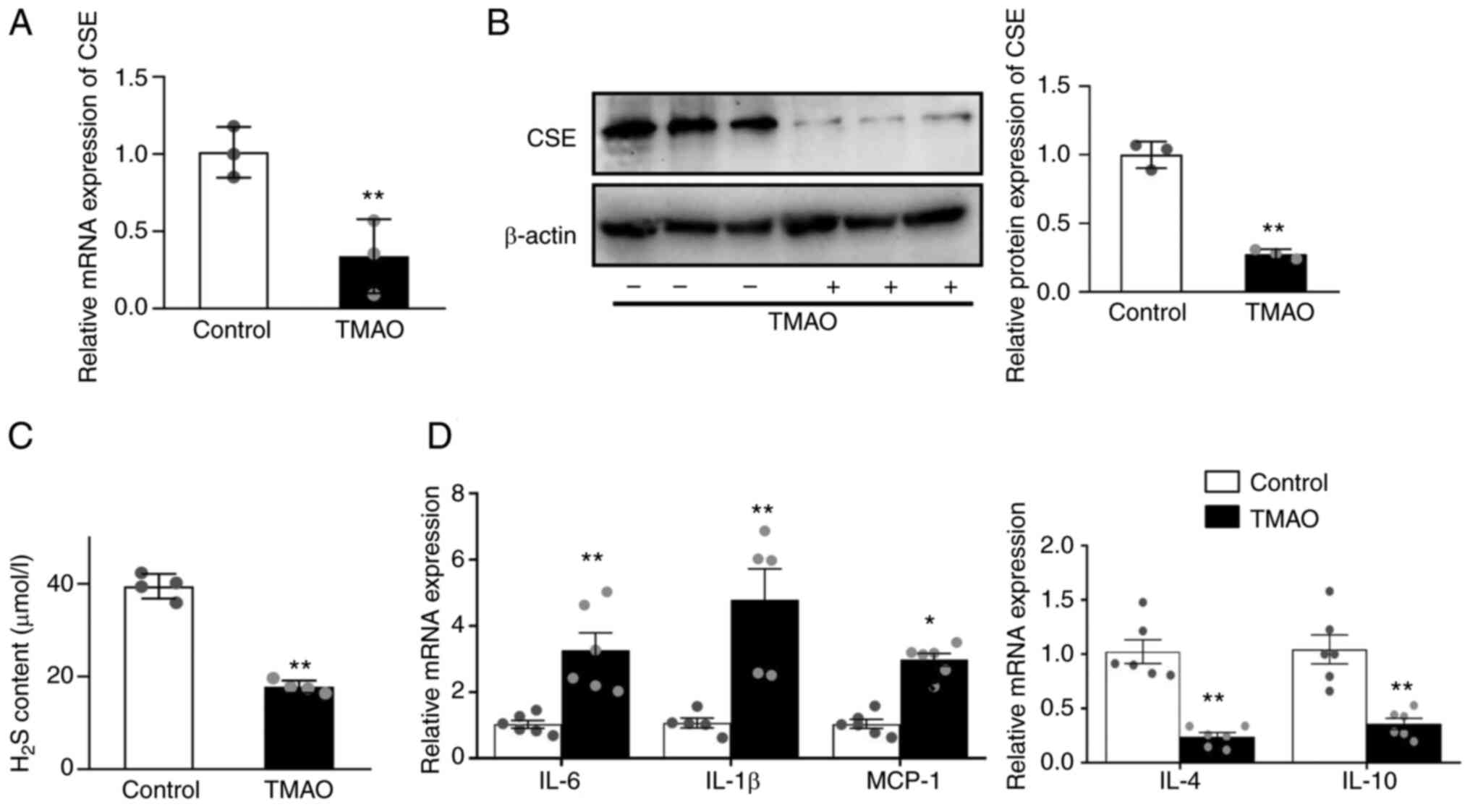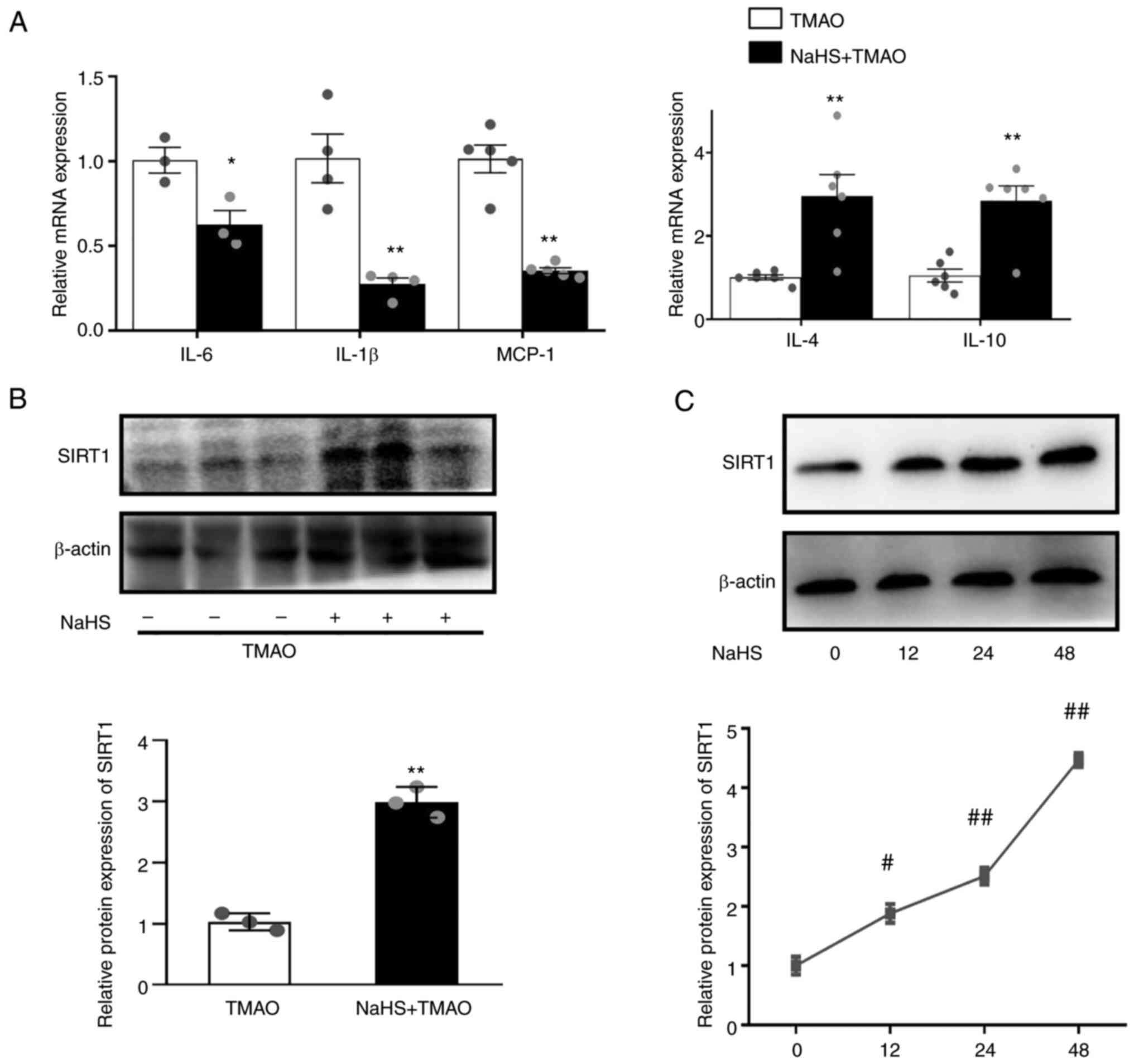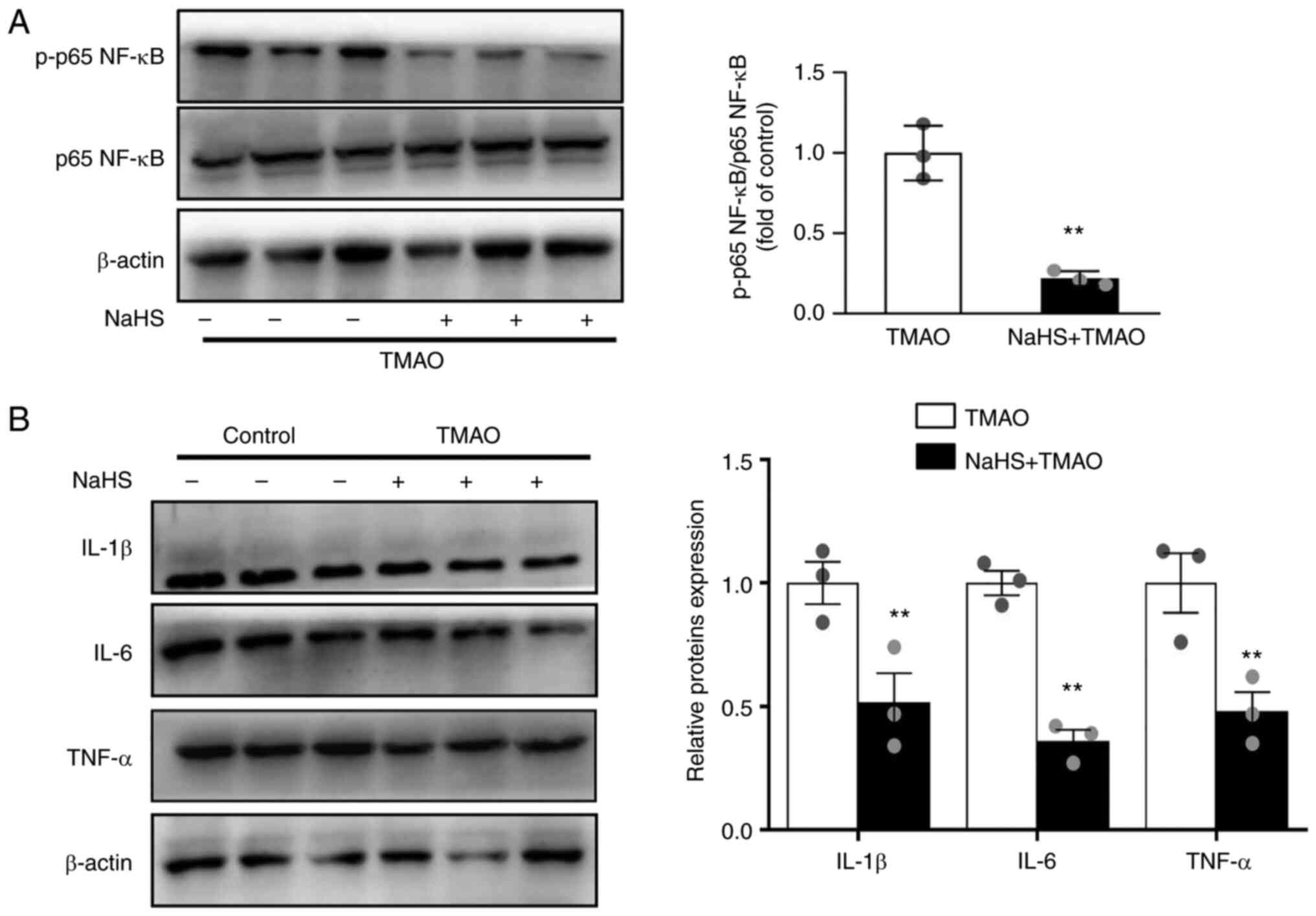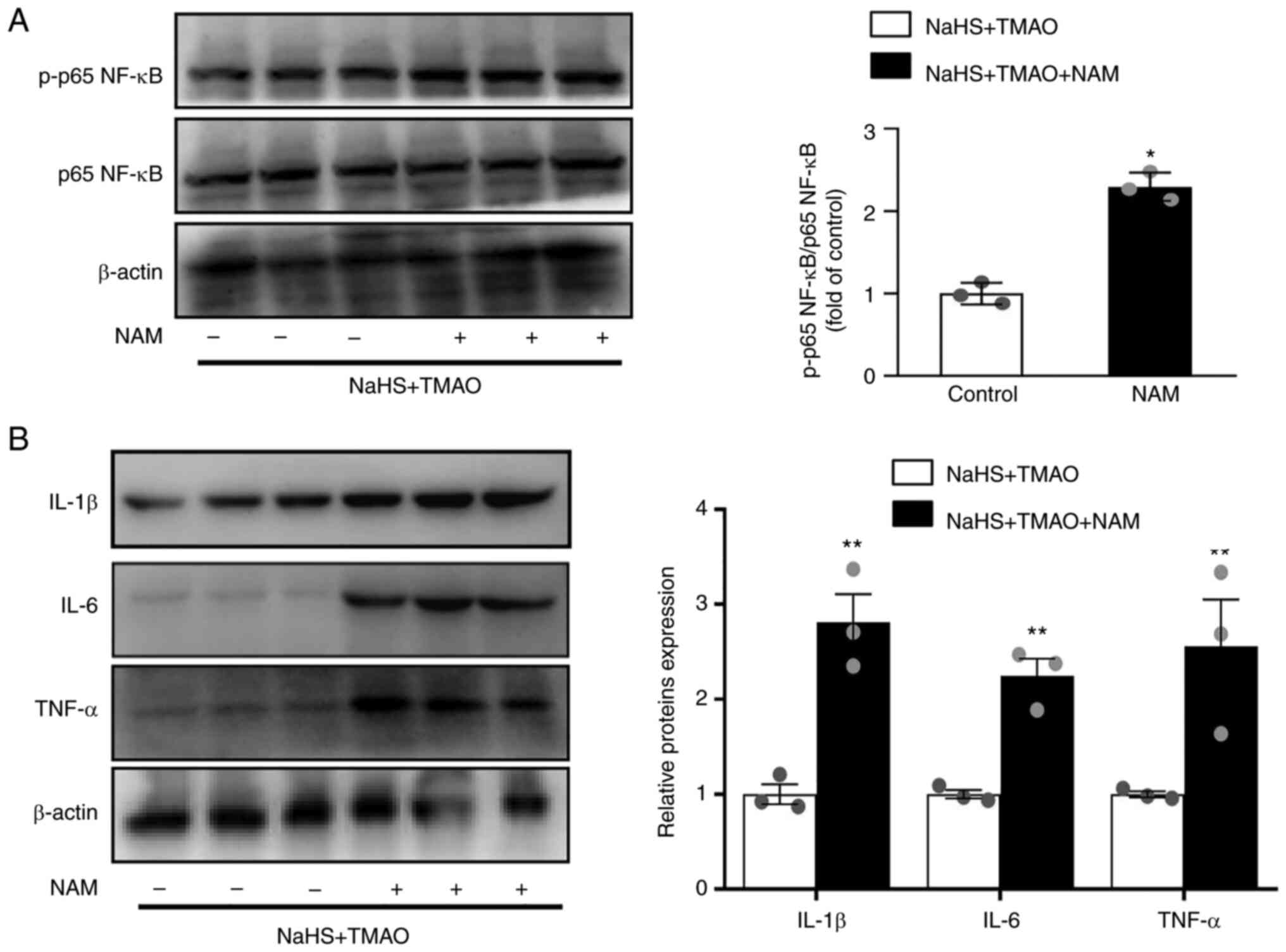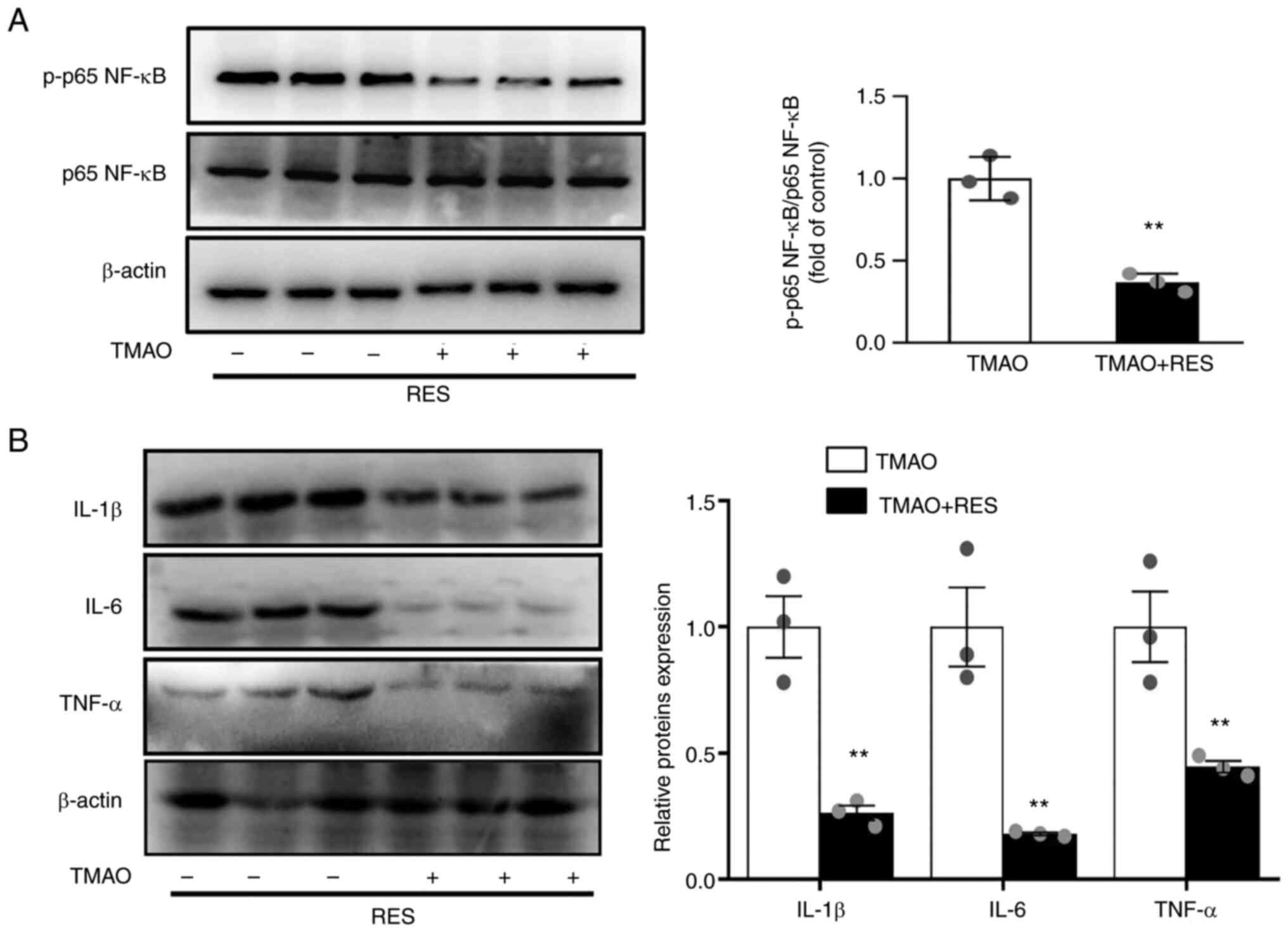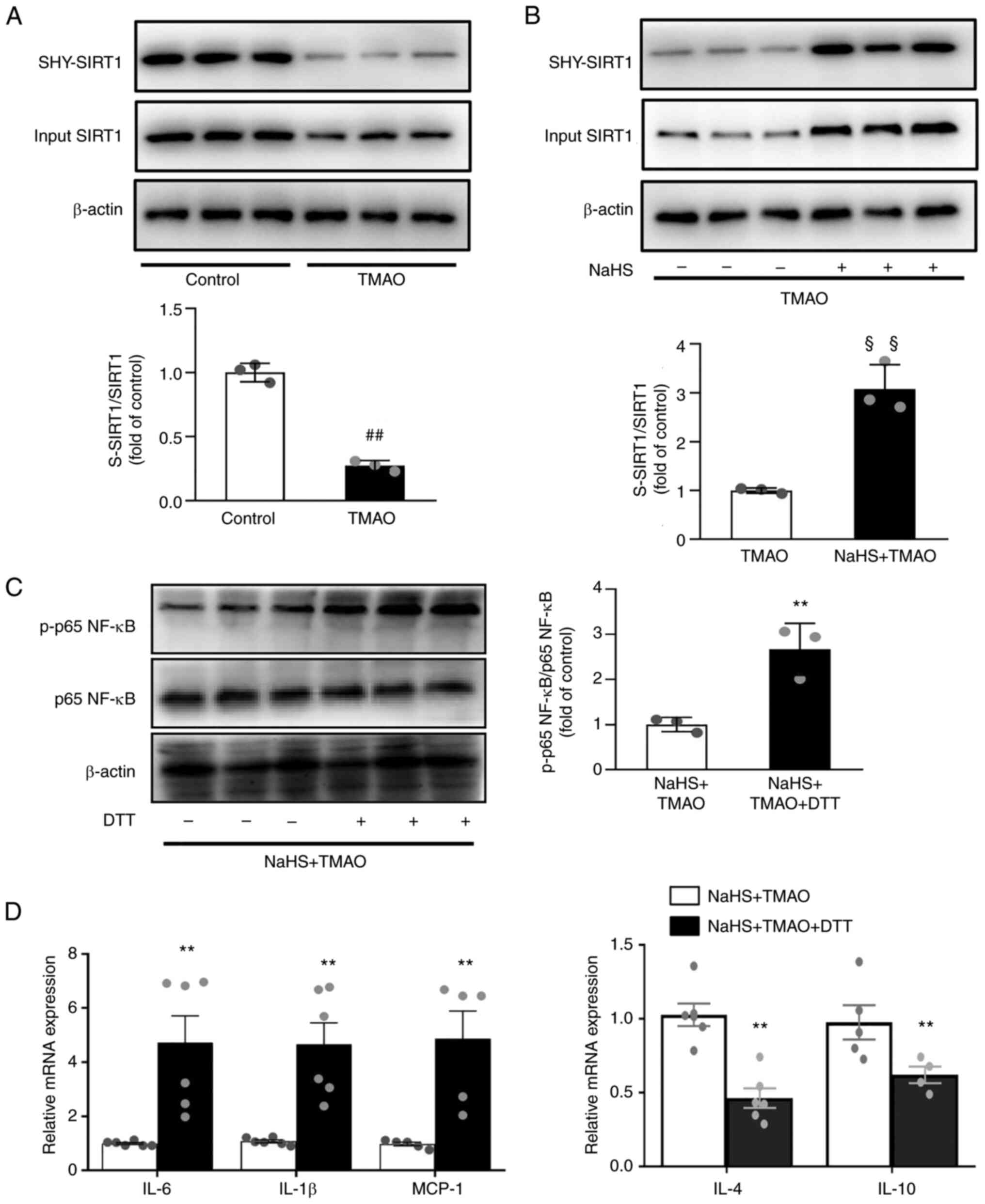Hydrogen sulfide attenuates TMAO‑induced macrophage inflammation through increased SIRT1 sulfhydration
- Authors:
- Published online on: May 16, 2023 https://doi.org/10.3892/mmr.2023.13016
- Article Number: 129
-
Copyright: © Liu et al. This is an open access article distributed under the terms of Creative Commons Attribution License.
Abstract
Introduction
An increasing amount of evidence has indicated that macrophage inflammation is an important pathological manifestation of inflammatory vascular diseases (1,2). The gut microbiota metabolite trimethylamine N-oxide (TMAO) has been shown to increase the incidence of major cardiovascular diseases (3). TMAO has been reported to promote activation of the NLR family pyrin domain containing 3 (NLRP3) inflammasome signaling pathway in endothelial cells (4) and vascular smooth muscle cells (VSMCs) (5), which can promote vascular inflammation and atherosclerosis. Notably, inhibition of TMAO production can attenuate atherosclerosis development in mice (6). However, the specific mechanistic link between TMAO and macrophage inflammation has not yet been elucidated. Therefore, investigating the specific mechanisms underlying TMAO-induced inflammation in macrophages is essential for the development of new therapeutics.
In mammalian cells, endogenous hydrogen sulfide (H2S) is synthesized by enzymatic catalysis. Cystathionine γ-lyase (CSE), cystathionine β-synthase (CBS) and 3-mercaptopyruvate sulfurtransferase (3-MST) are the major enzymes involved in catalyzing H2S synthesis (7). These enzymes that catalyze H2S synthesis are distributed in different tissues: CSE is predominantly expressed in the cardiovascular system, CBS is mainly expressed in the central nervous system, and 3-MST is expressed in human renal tissue, cardiomyocytes, neurons and the gastrointestinal tract (7,8). Previous studies have shown that H2S has a wide range of cardiovascular protective effects, including the inhibition of foam cell formation, endothelial inflammation, VSMC proliferation and platelet aggregation (9). CSE knockdown has been reported to result in decreased endogenous H2S production and increased atherosclerotic plaque formation (10). Furthermore, in a previous study, CSE expression significantly reduced plaque size in ApoE−/− mice (11). Whether H2S is involved in TMAO-induced macrophage inflammation remains unclear, despite significant progress in understanding the role of H2S in cardioprotection (12).
Sirtuin 1 (SIRT1) is an NAD+-dependent class III histone deacetylase that is widely expressed in various human organs. SIRT1 has numerous biological activities, including anti-inflammatory, anti-aging and antioxidative activities (13,14). Our previous studies indicated that SIRT1 is involved in H2S-mediated cardiovascular protection (15–17). SIRT1 activators E123 and 1evogliptin has been shown to protect against experimental atherosclerosis by lowering plasma cholesterol and triglycerides (18), and inhibiting the vascular inflammatory response (19). By contrast, SIRT1 inhibitor sirtinol has been shown to block the protective effects of H2S in foam cell formation and atherosclerosis (20,21). H2S has also been reported to act as a novel SIRT1 activator that can directly induce SIRT1 sulfhydration (22). Therefore, H2S may exert a broad protective effect against atherosclerosis by inducing SIRT1 sulfhydration. Based on the aforementioned studies, the present study investigated the modifying effects of H2S on SIRT1 sulfhydration and its regulatory role in TMAO-induced macrophage inflammation.
Materials and methods
Cell culture
RAW264.7 macrophages (American Type Culture Collection) were cultured in RPMI 1640 medium (HyClone; Cytiva) supplemented with 10% fetal bovine serum (FBS; Shanghai ExCell Biology, Inc.), 100 µg/ml streptomycin and 100 U/ml penicillin (both Beyotime Institute of Biotechnology) in an incubator at 37°C with 5% CO2. Before treatment, the macrophages were seeded in 100-mm dishes at a density of 2×106 cells/dish and were cultured with medium containing 10% FBS for 24 h, followed by starvation in 0.5% FBS-containing RPMI 1640 medium for 24 h at 37°C. RAW264.7 macrophages was used as the control. Subsequently, the macrophages were pretreated with 25 µM resveratrol (Sigma-Aldrich; Merck KGaA) for 24 h before TMAO (100 mM, Sigma-Aldrich) stimulation for 24 h. For certain experiments, the macrophages were pretreated with 40 mM SIRT1 inhibitor nicotinamide (Calbiochem; Merck KGaA) or DL-dithiothreitol (DTT; 1 mM, Phygene, China) for 60 min before sodium hydrosulfide (NaHS, 100 µmol/l, Sigma-Aldrich, USA) stimulation for 24 h at 37°C. To stimulate SIRT1 expression, macrophages were incubated with NaHS for 12, 24 or 48 h.
Modified biotin switch assay
The SIRT1 S-sulfhydration assay was performed as previously reported (22). The macrophages were lysed in HENS buffer [250 mM HEPES (pH 7.7), 1 mM EDTA, 0.1 mM Neocuproine, and 1% SDS] supplemented with protease inhibitors. The cell lysates were blocked with HEN blocking buffer [250 mM HEPES (pH 7.7), 1 mM EDTA, 0.1 mM Neocuproine] containing 20 mM methyl methanethiosulfonate (MMTS, Sigma-Aldrich) for 20 min at 50°C. Subsequently, MMTS was eliminated by precipitating with acetone for 20 min at −20°C. Thereafter, leaving a small part of the proteins as control (input SIRT1), the remaining proteins were resuspended in HENS buffer, and biotin-HPDP (4 mM, Thermo Scientific) was added for 4 h at 37°C. Subsequently, the remaining proteins were pulled down by streptavidin agarose (MilliporeSigma) at 4°C overnight under gentle shaking conditions. After centrifugation, biotinylated proteins (SHY-SIRT1) were resuspended in a protein loading buffer. Finally, the samples were analyzed by western blotting. Biotinylated proteins (SHY-SIRT1) were blotted together with total lysates (input SIRT1) and subjected to SIRT1 immunoblotting to assess SIRT1 sulfhydration.
H2S concentration measurement
As described previously (23), the supernatant of macrophages in control and TMAO group was collected and centrifuged at 12,000 g for 10 min at 4°C. H2S concentration measurement was performed according to the methylene blue method. Briefly, 800 µl supernatant was mixed sequentially with 8 µl NaOH (1 M), 80 µl 20 mM N, N-dimethyl-p-phenylenediamine sulfate in 7.2 M HCl, and 80 µl 30 mM FeCl3 in 1.2 M HCl. Subsequently, the mixtures were incubated at 37°C for 20 min. Finally, the formed methylene blue was detected at 668 nm using a microplate reader (ELx800; BioTek Instruments, Inc.). H2S concentration was quantified using a standard curve of NaHS.
Western blot analysis
The macrophages were lysed using ice-cold RIPA Lysis Buffer (cat. no. P0013B; Beyotime Institute of Biotechnology), containing a protease and phosphatase inhibitor cocktail (cat. no. P1045; Beyotime Institute of Biotechnology). Protein concentrations were measured using a BCA protein assay kit (cat. no. P0010S; Beyotime Institute of Biotechnology). Equal amounts of protein (80 µg) were separated by SDS-PAGE on 10 or 12% gels and were transferred onto PVDF membranes. The membranes were then blocked with 5% non-fat dry milk containing Tris-buffered saline −0.1% Tween 20 at 37°C for 2 h and were incubated with the following primary antibodies at 4°C overnight: CSE (1:1,000; cat. 60234-1-AP; Proteintech Group, Inc.), SIRT1 (1;750; cat. no. 13161-1-AP; Proteintech Group, Inc.), p65 NF-κB (1:800; cat. no. 8242; Cell Signaling Technology, Inc.), phosphorylated (p)-p65 NF-κB (1:750; cat. no. 3033; Cell Signaling Technology, Inc.), IL-1β (1:500; cat. no. WL00891; Wanleibio Co., Ltd.), IL-6 (1:600; cat. no. 21865-1-AP; Proteintech Group, Inc.), TNF-α (1:750; cat. no. 17590-1-AP; Proteintech Group, Inc.) and β-actin (1:5,000; cat. no. 20536-1-AP; Proteintech Group, Inc.). Subsequently, the membranes were incubated with a horseradish peroxidase-linked secondary antibody (1:5,000; cat. no. A0208 or A0216; Beyotime Institute of Biotechnology) for 2 h at 37°C. Eventually, images were acquired using a chemiluminescence reagent kit (WBKlS0100, MilliporeSigma) and the densities of the bands were analyzed using ImageJ 1.47i software (National Institutes of Health) for semi-quantification.
Reverse transcription-quantitative PCR (RT-qPCR)
Total RNA was isolated from the cells using TRIzol® reagent (cat. no. 15596-026; Invitrogen; Thermo Fisher Scientific, Inc.) and RT was performed with a high-capacity cDNA synthesis kit (cat. no. RR037A; Takara Bio, Inc.). The RT protocol was as follows: 37°C for 15 min, followed by 85°C for 5 sec, and finished at 4°C. qPCR analysis was performed using the SYBR Green PCR Mix kit (cat. no. DRR041A; Takara Bio, Inc.) and the ABI7500 System (Applied Biosystems; Thermo Fisher Scientific, Inc.). The thermocycling conditions were as follows: One cycle at 95°C for 30 sec, followed by 40 cycles at 95°C for 15 sec and 60°C for 30 sec. The PCR finished with extension at 60°C for 5 min and holding at 4°C. The relative fold changes in gene expression were normalized to the mRNA expression levels of β-actin and were analyzed using the 2−ΔΔCq method (24). The specific primer sequences are listed in Table I.
Statistical analysis
The data are presented as the mean ± SD. The significant differences between two groups were evaluated using an unpaired Student's t-test. Differences among multiple groups were analyzed by one-way analysis of variance with Tukey's post hoc test. All statistical analyses were performed using SPSS software (version 18; IBM Corp.). All experiments were performed with at least three independent biological samples. P<0.05 was considered to indicate a statistically significant difference.
Results
TMAO downregulates CSE and increases inflammatory cytokine levels
Macrophages were treated for 24 h with 100 mM TMAO to evaluate the effects of TMAO on CSE expression. In the present model, TMAO significantly decreased the mRNA and protein expression levels of CSE in macrophages (Fig. 1A and B) compared with the control group. In addition, TMAO treatment resulted in significantly lower levels of H2S measured in cell supernatants (Fig. 1C). TMAO upregulated the mRNA expression levels of IL-6, IL-1β and monocyte chemoattractant protein-1 (MCP-1), and downregulated IL-4 and IL-10 (Fig. 1D).
NaHS upregulates SIRT1 levels and reduces inflammation in TMAO-stimulated macrophages
H2S-induced SIRT1 has been reported to confer a protective effect on atherosclerosis (22). NaHS is a donor of H2S. NaHS downregulated the mRNA expression levels of IL-6, IL-1β and MCP-1, and upregulated the expression levels of IL-4 and IL-10 (Fig. 2A) compared with that in the TMAO group. In addition, NaHS significantly increased the protein expression levels of SIRT1 when RAW264.7 macrophages were challenged with TMAO (Fig. 2B). Furthermore, NaHS induced SIRT1 expression in a time-dependent manner (Fig. 2C) after 12, 24 and 48 h of incubation.
NaHS ameliorates TMAO-induced NF-κB activation
Recent studies have shown that TMAO activates NF-κB signals, resulting in the release of inflammatory cytokines (5,25). The present study examined the effects of H2S on TMAO-induced NF-κB activation. As shown in Fig. 3A, the TMAO-induced phosphorylation of p65 NF-κB was reversed by NaHS. In addition, NaHS decreased the expression levels of the pro-inflammatory cytokines IL-1β, IL-6 and TNF-α in TMAO-stimulated macrophages (Fig. 3B).
NaHS reduces inflammation via enhanced SIRT1 activity
Macrophages were treated with the SIRT1 inhibitor nicotinamide to investigate whether SIRT1 mediated the protective effect of H2S on TMAO-induced NF-κB activation. The results showed that phosphorylation of p65 NF-κB was significantly increased by nicotinamide compared with that in the NaHS+ TMAO group (Fig. 4A). Furthermore, the protein expression levels of IL-1β, IL-6, and TNF-α were also increased by nicotinamide (Fig. 4B).
Resveratrol counteracts TMAO-induced NF-κB activation via SIRT1
Resveratrol has been identified as a SIRT1 activator, which can modulate the inflammatory response in endothelial cells by inhibiting NF-κB activation (26). Resveratrol reversed the TMAO-induced phosphorylation of p65 NF-κB (Fig. 5A). In addition, resveratrol significantly ameliorated the TMAO-induced expression of IL-1β, IL-6 and TNF-α (Fig. 5B).
H2S inhibits NF-κB activation via S-sulfhydrated SIRT1
S-sulfhydration refers to the formation of hydropersulfide (−SSH) from H2S by attaching sulfur to thiol (−SH) groups of cysteines (27). The results revealed that TMAO significantly decreased SIRT1 sulfhydration (Fig. 6A). By contrast, SIRT1 sulfhydration was induced after NaHS treatment in TMAO-stimulated macrophages (Fig. 6B). Given that S-sulfhydrated SIRT1 can reduce inflammation (28), the present study evaluated its effects on NF-κB activation. Following pre-treatment with the thiol-reducing agent DTT in macrophages, the inhibitory effect of NaHS on NF-κB activation was significantly reversed (Fig. 6C). DTT also upregulated the mRNA expression levels of IL-1β, IL-6 and MCP-1, and downregulated IL-4 and IL-10 (Fig. 6D) compared with that in the NaHS +TMAO group. These data indicated that H2S may attenuate TMAO-induced inflammatory signaling in macrophages by inducing SIRT1 sulfhydration.
Discussion
It has been reported that increased TMAO levels are associated with the development of metabolic diseases, such as diabetes and atherosclerosis (29). To the best of our knowledge, the present study demonstrated for the first time that H2S was negatively associated with TMAO-induced macrophage inflammation. Mechanistically, it was revealed that H2S promoted SIRT1 sulfhydration and decreased SIRT1 proteasomal degradation, reducing the phosphorylation of P65 NF-κB, and inhibiting inflammation (Fig. 7). Thus, these results indicated that NaHS attenuated TMAO-induced macrophage inflammation, suggesting that targeting H2S may be useful in developing novel therapeutic strategies for TMAO-induced cardiovascular events.
TMAO, an intestinal microbial metabolite, has been associated with cardiovascular disease (30). Clinical studies have shown that high TMAO levels are significantly associated with an increased risk of major adverse cardiovascular events (31). TMAO exposure has also been shown to promote endothelial cell inflammation via activation of the NLRP3 inflammasome (32). The present study showed that TMAO induced the expression of inflammatory cytokines in macrophages.
Our previous studies indicated that H2S has powerful antioxidative (33) and cytoprotective effects (16,23,34) on cardiovascular systems. In addition, H2S exhibits a significant ability to protect against inflammation (1,35). H2S can inhibit the TLR4/NF-κB pathway (35,36), scavenge excess reactive oxygen species (37,38) and suppress HMGB1 (39), which are related to NLRP3 activation (40,41) and ferroptosis (42,43). Recently, H2S has been proven to relieve myocardial infarction by promoting M2 macrophage polarization, macrophage migration and infiltration (1). CSE is the main enzyme for H2S production in the cardiovascular system. In the present study, it was revealed that TMAO significantly decreased CSE expression and increased expression of pro-inflammatory M1 cytokines, resulting in increased M1 polarization and inflammatory response in macrophages. Notably, the endogenous production of H2S is largely dependent on the activity of CSE and is less dependent on the activity of CBS or 3-MST in macrophages (44). Previous studies have identified that TMAO significantly decreases plasma H2S levels (40,45). However, the present study did not investigate whether TMAO influenced the expression levels of CBS and 3-MST in macrophages; therefore, this study has some limitations, which require further study in the future. Moreover, the present data revealed that H2S promotes a shift from the M1 to M2 macrophage phenotype by decreasing the expression of pro-inflammatory M1 cytokines and by increasing anti-inflammatory M2 cytokines in TMAO-stimulated macrophages, which is consistent with an earlier report (46). Thus, H2S may be considered a potentially promising therapeutic approach to the treatment of TMAO-induced macrophage inflammation.
SIRT1 is important in the regulation of inflammation and atherosclerosis (47). SIRT1 activation has been shown to ameliorate endothelial function, reduce foam cell formation (48) and attenuate atherosclerotic plaque formation (49). Specific knockdown of SIRT1 in endothelial cells (50) or VSMCs (51) can significantly increase atherosclerotic plaque area. Our previous study indicated that H2S induced SIRT1 activation in human umbilical vein endothelial cells (17). The present study demonstrated that NaHS increased SIRT1 expression in TMAO-exposed macrophages, indicating the importance of H2S in SIRT1 signaling activation. A number of studies have revealed that SIRT1 serves as a potential mediator of NLRP3 inflammasome activation and ferroptosis in chronic inflammation (52,53). NF-κB activity is regulated by post-translational modifications, such as acetylation and phosphorylation (54,55). Notably, SIRT1 signaling has been shown to alleviate NF-κB activity in macrophages after stimulation of the cells with lipopolysaccharide (56). Activating SIRT1 can also deacetylate NF-κB p65 (52) or p53 (53) to alleviate NLRP3 inflammasome activation and ferroptosis in macrophages. Furthermore, SIRT1 defects may lead to NLRP3 activation in hepatocytes (57) or ferroptosis in H9c2 cardiomyocyte cells (58), and thereby SIRT1 signaling relieves inflammation. The present study further verified that TMAO induced activation of the NF-κB signaling pathway by increasing the phosphorylation of p65 NF-κB. Moreover, the SIRT1 inhibitor nicotinamide significantly increased the phosphorylation of p65 NF-κB and impaired the anti-inflammatory actions of H2S. Conversely, the SIRT1 activator resveratrol attenuated the phosphorylation of p65 NF-κB and inflammation in macrophages. Accordingly, SIRT1 mediates the protective effect of H2S on TMAO-induced NF-κB activation in macrophages. A previous study also revealed that SIRT1 directly acetylates P65 and promotes inflammation (59). However, the present study did not exclude the effect of SIRT1-induced P65 acetylation on inflammation. Nevertheless, inhibition of P65 phosphorylation by SIRT1 is involved in the protective effects of H2S against TMAO-induced inflammation in macrophages. The present findings suggested that H2S inhibited NF-κB p65 mediated inflammatory activation via enhanced SIRT1 activation.
S-sulfhydration is a post-translational modification that increases SIRT1 protein stability and activity (22). NaHS promotes SIRT1 expression and activity by sulfhydrating SIRT1, thereby lowering its ubiquitin-dependent degradation (22). In addition, SIRT1 sulfhydration reduces acetylation and phosphorylation of P65 NF-κB, ultimately inhibiting inflammation (22,28). The present study discovered that NaHS induced SIRT1 sulfhydration to enhance SIRT1 stability and protein levels, which is similar to the findings of a previous study (22). Furthermore, SIRT1 sulfhydration by H2S decreases the phosphorylation of p65 NF-κB, which downregulates pro-inflammatory cytokine expression in TMAO-exposed macrophages. However, DTT blocked its action, suggesting that SIRT1 sulfhydration mediated the effects of H2S. Therefore, the present study indicated that SIRT1 sulfhydration mediated the protective effects of H2S on TMAO-induced M1 polarization and inflammation in macrophages.
In conclusion, the present study demonstrated that H2S can attenuate TMAO-induced inflammatory signaling in macrophages via the upregulation and sulfhydration of SIRT1. The present study not only provided information on the mechanisms underlying H2S-mediated anti-inflammatory effects, but also provided evidence that SIRT1 is involved in the protective effects of H2S on TMAO-associated macrophage inflammation.
Acknowledgements
Not applicable.
Funding
This study was supported by grants from the Guiding Technology Plan of Ganzhou City (grant no. GZ2022ZSF186), the Jiangxi Provincial Natural Science Foundation (grant no. 20224BAB206020), the Science and Technology Plan Project of Jiangxi Provincial Health Commission (grant no. 202210091/SKJP_220217891), and the Science and Technology Plan of Jiangxi Provincial Administration of Traditional Chinese Medicine (grant no. 2022A337).
Availability of data and materials
The datasets used and/or analyzed during the current study are available from the corresponding author on reasonable request.
Authors' contributions
MHL collected and analyzed the data and wrote the manuscript. MHL and LLX performed the experiments. XLL contributed to the study design and data analyses and revised the manuscript. All authors read and approved the final manuscript. MHL and LLX confirm the authenticity of all the raw data.
Ethics approval and consent to participate
Not applicable.
Patient consent for publication
Not applicable.
Competing interests
The authors declare that they have no known competing interests.
References
|
Zhang H, Du J, Huang Y, Tang C and Jin H: Hydrogen sulfide regulates macrophage function in cardiovascular diseases. Antioxid Redox Signal. 38:45–56. 2023. View Article : Google Scholar : PubMed/NCBI | |
|
Susser LI and Rayner KJ: Through the layers: How macrophages drive atherosclerosis across the vessel wall. J Clin Invest. 132:e1570112022. View Article : Google Scholar : PubMed/NCBI | |
|
Tang WH and Hazen SL: The contributory role of gut microbiota in cardiovascular disease. J Clin Invest. 124:4204–4211. 2014. View Article : Google Scholar : PubMed/NCBI | |
|
Sun X, Jiao X, Ma Y, Liu Y, Zhang L, He Y and Chen Y: Trimethylamine N-oxide induces inflammation and endothelial dysfunction in human umbilical vein endothelial cells via activating ROS-TXNIP-NLRP3 inflammasome. Biochem Biophys Res Commun. 481:63–70. 2016. View Article : Google Scholar : PubMed/NCBI | |
|
Zhang X, Li Y, Yang P, Liu X, Lu L, Chen Y, Zhong X, Li Z, Liu H, Ou C, et al: Trimethylamine-N-oxide promotes vascular calcification through activation of NLRP3 (nucleotide-binding domain, leucine-rich-containing family, pyrin domain-containing-3) inflammasome and NF-κB (nuclear factor κB) signals. Arterioscler Thromb Vasc Biol. 40:751–765. 2020. View Article : Google Scholar : PubMed/NCBI | |
|
Zhang W, Miikeda A, Zuckerman J, Jia X, Charugundla S, Zhou Z, Kaczor-Urbanowicz KE, Magyar C, Guo F, Wang Z, et al: Inhibition of microbiota-dependent TMAO production attenuates chronic kidney disease in mice. Sci Rep. 11:5182021. View Article : Google Scholar : PubMed/NCBI | |
|
Casin KM and Calvert JW: Harnessing the benefits of endogenous hydrogen sulfide to reduce cardiovascular disease. Antioxidants (Basel). 10:3832021. View Article : Google Scholar : PubMed/NCBI | |
|
Lv B, Chen S, Tang C, Jin H, Du J and Huang Y: Hydrogen sulfide and vascular regulation-an update. J Adv Res. 27:85–97. 2020. View Article : Google Scholar : PubMed/NCBI | |
|
Liu HT, Zhou ZX, Ren Z, Yang S, Liu LS, Wang Z, Wei DH, Ma XF, Ma Y and Jiang ZS: EndMT: Potential target of H2S against atherosclerosis. Curr Med Chem. 28:3666–3680. 2021. View Article : Google Scholar : PubMed/NCBI | |
|
Mani S, Li H, Untereiner A, Wu L, Yang G, Austin RC, Dickhout JG, Lhoták Š, Meng QH and Wang R: Decreased endogenous production of hydrogen sulfide accelerates atherosclerosis. Circulation. 127:2523–2534. 2013. View Article : Google Scholar : PubMed/NCBI | |
|
Cheung SH, Kwok WK, To KF and Lau JYW: Anti-atherogenic effect of hydrogen sulfide by over-expression of cystathionine gamma-lyase (CSE) gene. PLoS One. 9:e1130382014. View Article : Google Scholar : PubMed/NCBI | |
|
Liao M, Liu Y, Yuan J, Wen Y, Xu G, Zhao J, Cheng L, Li J, Wang X, Wang F, et al: Single-cell landscape of bronchoalveolar immune cells in patients with COVID-19. Nat Med. 26:842–844. 2020. View Article : Google Scholar : PubMed/NCBI | |
|
Winnik S, Auwerx J, Sinclair DA and Matter CM: Protective effects of sirtuins in cardiovascular diseases: From bench to bedside. Eur Heart J. 36:3404–3412. 2015. View Article : Google Scholar : PubMed/NCBI | |
|
Lin XL, Liu Y, Liu M, Hu H, Pan Y, Fan XJ, Hu XM and Zou WW: Inhibition of hydrogen peroxide-induced human umbilical vein endothelial cells aging by allicin depends on sirtuin1 activation. Med Sci Monit. 23:563–570. 2017. View Article : Google Scholar : PubMed/NCBI | |
|
Luo XY, Qu SL, Tang ZH, Zhang Y, Liu MH, Peng J, Tang H, Yu KL, Zhang C, Ren Z and Jiang ZS: SIRT1 in cardiovascular aging. Clin Chim Acta. 437:106–114. 2014. View Article : Google Scholar : PubMed/NCBI | |
|
Zhang Y, Tang ZH, Ren Z, Qu SL, Liu MH, Liu LS and Jiang ZS: Hydrogen sulfide, the next potent preventive and therapeutic agent in aging and age-associated diseases. Mol Cell Biol. 33:1104–1113. 2013. View Article : Google Scholar : PubMed/NCBI | |
|
Suo R, Zhao ZZ, Tang ZH, Ren Z, Liu X, Liu LS, Wang Z, Tang CK, Wei DH and Jiang ZS: Hydrogen sulfide prevents H2O2 induced senescence in human umbilical vein endothelial cells through SIRT1 activation. Mol Med Rep. 7:1865–1870. 2013. View Article : Google Scholar : PubMed/NCBI | |
|
Feng T, Liu P, Wang X, Luo J, Zuo X, Jiang X, Liu C, Li Y, Li N, Chen M, et al: SIRT1 activator E1231 protects from experimental atherosclerosis and lowers plasma cholesterol and triglycerides by enhancing ABCA1 expression. Atherosclerosis. 274:172–181. 2018. View Article : Google Scholar : PubMed/NCBI | |
|
Nguyen PA, Won JS, Rahman MK, Bae EJ and Cho MK: Modulation of Sirt1/NF-κB interaction of evogliptin is attributed to inhibition of vascular inflammatory response leading to attenuation of atherosclerotic plaque formation. Biochem Pharmacol. 168:452–464. 2019. View Article : Google Scholar : PubMed/NCBI | |
|
Li X, Zhang KY, Zhang P, Chen LX, Wang L, Xie M, Wang CY and Tang XQ: Hydrogen sulfide inhibits formaldehyde-induced endoplasmic reticulum stress in PC12 cells by upregulation of SIRT-1. PLoS One. 9:e898562014. View Article : Google Scholar : PubMed/NCBI | |
|
Stein S, Lohmann C, Schäfer N, Hofmann J, Rohrer L, Besler C, Rothgiesser KM, Becher B, Hottiger MO, Borén J, et al: SIRT1 decreases Lox-1-mediated foam cell formation in atherogenesis. Eur Heart J. 31:2301–2309. 2010. View Article : Google Scholar : PubMed/NCBI | |
|
Du C, Lin X, Xu W, Zheng F, Cai J, Yang J, Cui Q, Tang C, Cai J, Xu G and Geng B: Sulfhydrated sirtuin-1 increasing its deacetylation activity is an essential epigenetics mechanism of anti-atherogenesis by hydrogen sulfide. Antioxid Redox Signal. 30:184–197. 2019. View Article : Google Scholar : PubMed/NCBI | |
|
Huang YE, Tang ZH, Xie W, Shen XT, Liu MH, Peng XP, Zhao ZZ, Nie DB, Liu LS and Jiang ZS: Endogenous hydrogen sulfide mediates the cardioprotection induced by ischemic postconditioning in the early reperfusion phase. Exp Ther Med. 4:1117–1123. 2012. View Article : Google Scholar : PubMed/NCBI | |
|
Livak KJ and Schmittgen TD: Analysis of relative gene expression data using real-time quantitative PCR and the 2(−Delta Delta C(T)) method. Methods. 25:402–408. 2001. View Article : Google Scholar : PubMed/NCBI | |
|
Chen CY, Leu HB, Wang SC, Tsai SH, Chou RH, Lu YW, Tsai YL, Kuo CS, Huang PH, Chen JW and Lin SJ: Inhibition of trimethylamine N-oxide attenuates neointimal formation through reduction of inflammasome and oxidative stress in a mouse model of carotid artery ligation. Antioxid Redox Signal. 38:215–233. 2023. View Article : Google Scholar : PubMed/NCBI | |
|
Nallasamy P, Kang ZY, Sun X, Anandh Babu PV, Liu D and Jia Z: Natural compound resveratrol attenuates TNF-alpha-induced vascular dysfunction in mice and human endothelial cells: The Involvement of the NF-κB signaling pathway. Int J Mol Sci. 22:124862021. View Article : Google Scholar : PubMed/NCBI | |
|
Gupta R, Sahu M, Tripathi R, Ambasta RK and Kumar P: Protein S-sulfhydration: Unraveling the prospective of hydrogen sulfide in the brain, vasculature and neurological manifestations. Ageing Res Rev. 76:1015792022. View Article : Google Scholar : PubMed/NCBI | |
|
Sun HJ, Xiong SP, Cao X, Cao L, Zhu MY, Wu ZY and Bian JS: Polysulfide-mediated sulfhydration of SIRT1 prevents diabetic nephropathy by suppressing phosphorylation and acetylation of p65 NF-κB and STAT3. Redox Biol. 38:1018132021. View Article : Google Scholar : PubMed/NCBI | |
|
Fu BC, Hullar MAJ, Randolph TW, Franke AA, Monroe KR, Cheng I, Wilkens LR, Shepherd JA, Madeleine MM, Le Marchand L, et al: Associations of plasma trimethylamine N-oxide, choline, carnitine, and betaine with inflammatory and cardiometabolic risk biomarkers and the fecal microbiome in the multiethnic cohort adiposity phenotype study. Am J Clin Nutr. 111:1226–1234. 2020. View Article : Google Scholar : PubMed/NCBI | |
|
Tang WHW and Hazen SL: Microbiome, trimethylamine N-oxide, and cardiometabolic disease. Transl Res. 179:108–115. 2017. View Article : Google Scholar : PubMed/NCBI | |
|
Stubbs JR, House JA, Ocque AJ, Zhang S, Johnson C, Kimber C, Schmidt K, Gupta A, Wetmore JB, Nolin TD, et al: Serum trimethylamine-N-oxide is elevated in CKD and correlates with coronary atherosclerosis burden. J Am Soc Nephrol. 27:305–313. 2016. View Article : Google Scholar : PubMed/NCBI | |
|
Chen ML, Zhu XH, Ran L, Lang HD, Yi L and Mi MT: Trimethylamine-N-oxide induces vascular inflammation by activating the NLRP3 inflammasome through the SIRT3-SOD2-mtROS signaling pathway. J Am Heart Assoc. 6:e0063472017. View Article : Google Scholar : PubMed/NCBI | |
|
Liu MH, Lin XL, Zhang Y, He J, Tan TP, Wu SJ, Liu J, Tian W, Chen L, Yu S, et al: Hydrogen sulfide attenuates doxorubicin-induced cardiotoxicity by inhibiting reactive oxygen species-activated extracellular signal-regulated kinase 1/2 in H9c2 cardiac myocytes. Mol Med Rep. 12:6841–6848. 2015. View Article : Google Scholar : PubMed/NCBI | |
|
Liu MH, Zhang Y, He J, Tan TP, Wu SJ, Guo DM, He H, Peng J, Tang ZH and Jiang ZS: Hydrogen sulfide protects H9c2 cardiac cells against doxorubicin-induced cytotoxicity through the PI3K/Akt/FoxO3a pathway. Int J Mol Med. 37:1661–1668. 2016. View Article : Google Scholar : PubMed/NCBI | |
|
Luo ZL, Ren JD, Huang Z, Wang T, Xiang K, Cheng L and Tang LJ: The role of exogenous hydrogen sulfide in free fatty acids induced inflammation in macrophages. Cell Physiol Biochem. 42:1635–1644. 2017. View Article : Google Scholar : PubMed/NCBI | |
|
Zhang D, Wu C, Ba D, Wang N, Wang Y, Li X, Li Q and Zhao G: Ferroptosis contribute to neonicotinoid imidacloprid-evoked pyroptosis by activating the HMGB1-RAGE/TLR4-NF-κB signaling pathway. Ecotoxicol Environ Saf. 253:1146552023. View Article : Google Scholar : PubMed/NCBI | |
|
Olas B: Hydrogen sulfide as a ‘double-faced’ compound: One with Pro- and antioxidant effect. Adv Clin Chem. 78:187–196. 2017. View Article : Google Scholar : PubMed/NCBI | |
|
Wang Y, Yu R, Wu L and Yang G: Hydrogen sulfide guards myoblasts from ferroptosis by inhibiting ALOX12 acetylation. Cell Signal. 78:1098702021. View Article : Google Scholar : PubMed/NCBI | |
|
Zhao X, Zhang L, Liu X, Zhao Z, Zhong X and Wang Y: Exogenous hydrogen sulfide inhibits neutrophils extracellular traps formation via the HMGB1/TLR4/p-38 MAPK/ROS axis in hyperhomocysteinemia rats. Biochem Biophys Res Commun. 537:7–14. 2021. View Article : Google Scholar : PubMed/NCBI | |
|
Bai L, Dai J, Xia Y, He K, Xue H, Guo Q, Tian D, Xiao L, Zhang X, Teng X, et al: Hydrogen sulfide ameliorated high choline-induced cardiac dysfunction by inhibiting cGAS-STING-NLRP3 inflammasome pathway. Oxid Med Cell Longev. 2022:13928962022. View Article : Google Scholar : PubMed/NCBI | |
|
Qin M, Long F, Wu W, Yang D, Huang M, Xiao C, Chen X, Liu X and Zhu YZ: Hydrogen sulfide protects against DSS-induced colitis by inhibiting NLRP3 inflammasome. Free Radic Biol Med. 137:99–109. 2019. View Article : Google Scholar : PubMed/NCBI | |
|
Wang Y, Liao S, Pan Z, Jiang S, Fan J, Yu S, Xue L, Yang J, Ma S, Liu T, et al: Hydrogen sulfide alleviates particulate matter-induced emphysema and airway inflammation by suppressing ferroptosis. Free Radic Biol Med. 186:1–16. 2022. View Article : Google Scholar : PubMed/NCBI | |
|
Zhao Z, Li G, Wang Y, Li Y, Xu H, Liu W, Hao W, Yao Y and Zeng R: Cytoplasmic HMGB1 induces renal tubular ferroptosis after ischemia/reperfusion. Int Immunopharmacol. 116:1097572023. View Article : Google Scholar : PubMed/NCBI | |
|
Castelblanco M, Lugrin J, Ehirchiou D, Nasi S, Ishii I, So A, Martinon F and Busso N: Hydrogen sulfide inhibits NLRP3 inflammasome activation and reduces cytokine production both in vitro and in a mouse model of inflammation. J Biol Chem. 293:2546–2557. 2018. View Article : Google Scholar : PubMed/NCBI | |
|
Koeth RA, Lam-Galvez BR, Kirsop J, Wang Z, Levison BS, Gu X, Copeland MF, Bartlett D, Cody DB, Dai HJ, et al: l-Carnitine in omnivorous diets induces an atherogenic gut microbial pathway in humans. J Clin Invest. 129:373–387. 2019. View Article : Google Scholar : PubMed/NCBI | |
|
Feng S, Chen S, Yu W, Zhang D, Zhang C, Tang C, Du J and Jin H: H2S inhibits pulmonary arterial endothelial cell inflammation in rats with monocrotaline-induced pulmonary hypertension. Lab Invest. 97:268–278. 2017. View Article : Google Scholar : PubMed/NCBI | |
|
Zhang QJ, Wang Z, Chen HZ, Zhou S, Zheng W, Liu G, Wei YS, Cai H, Liu DP and Liang CC: Endothelium-specific overexpression of class III deacetylase SIRT1 decreases atherosclerosis in apolipoprotein E-deficient mice. Cardiovasc Res. 80:191–199. 2008. View Article : Google Scholar : PubMed/NCBI | |
|
Liu Z, Han Y, Li L, Lu H, Meng G, Li X, Shirhan M, Peh MT, Xie L, Zhou S, et al: The hydrogen sulfide donor, GYY4137, exhibits anti-atherosclerotic activity in high fat fed apolipoprotein E(−/-) mice. Br J Pharmacol. 169:1795–1809. 2013. View Article : Google Scholar : PubMed/NCBI | |
|
Miranda MX, van Tits LJ, Lohmann C, Arsiwala T, Winnik S, Tailleux A, Stein S, Gomes AP, Suri V, Ellis JL, et al: The Sirt1 activator SRT3025 provides atheroprotection in Apoe-/- mice by reducing hepatic Pcsk9 secretion and enhancing Ldlr expression. Eur Heart J. 36:51–59. 2015. View Article : Google Scholar : PubMed/NCBI | |
|
Wen L, Chen Z, Zhang F, Cui X, Sun W, Geary GG, Wang Y, Johnson DA, Zhu Y, Chien S and Shyy JY: Ca2+/calmodulin-dependent protein kinase kinase β phosphorylation of sirtuin 1 in endothelium is atheroprotective. Proc Natl Acad Sci USA. 110:E2420–E2427. 2013. View Article : Google Scholar : PubMed/NCBI | |
|
Gorenne I, Kumar S, Gray K, Figg N, Yu H, Mercer J and Bennett M: Vascular smooth muscle cell sirtuin 1 protects against DNA damage and inhibits atherosclerosis. Circulation. 127:386–396. 2013. View Article : Google Scholar : PubMed/NCBI | |
|
He S, Wang Y, Liu J, Li P, Luo X and Zhang B: Activating SIRT1 deacetylates NF-κB p65 to alleviate liver inflammation and fibrosis via inhibiting NLRP3 pathway in macrophages. Int J Med Sci. 20:505–519. 2023. View Article : Google Scholar : PubMed/NCBI | |
|
Chen H, Lin X, Yi X, Liu X, Yu R, Fan W, Ling Y, Liu Y and Xie W: SIRT1-mediated p53 deacetylation inhibits ferroptosis and alleviates heat stress-induced lung epithelial cells injury. Int J Hyperthermia. 39:977–986. 2022. View Article : Google Scholar : PubMed/NCBI | |
|
Breitenstein A, Stein S, Holy EW, Camici GG, Lohmann C, Akhmedov A, Spescha R, Elliott PJ, Westphal CH, Matter CM, et al: Sirt1 inhibition promotes in vivo arterial thrombosis and tissue factor expression in stimulated cells. Cardiovasc Res. 89:464–472. 2011. View Article : Google Scholar : PubMed/NCBI | |
|
Fiordelisi A, Iaccarino G, Morisco C, Coscioni E and Sorriento D: NFkappaB is a key player in the crosstalk between inflammation and cardiovascular diseases. Int J Mol Sci. 20:15992019. View Article : Google Scholar : PubMed/NCBI | |
|
Yuan Q, Zhang D, Liu C, Zhang C and Yuan D: Chikusetsusaponin V inhibits LPS-activated inflammatory responses via SIRT1/NF-κB signaling pathway in RAW264.7 cells. Inflammation. 41:2149–2159. 2018. View Article : Google Scholar : PubMed/NCBI | |
|
Adjei-Mosi J, Sun Q, Smithson SB, Shealy GL, Amerineni KD, Liang Z, Chen H, Wang M, Ping Q, Han J, et al: Age-dependent loss of hepatic SIRT1 enhances NLRP3 inflammasome signaling and impairs capacity for liver fibrosis resolution. Aging Cell. e138112023.(Epub ahead of print). View Article : Google Scholar : PubMed/NCBI | |
|
Li D, Liu X, Pi W, Zhang Y, Yu L, Xu C, Sun Z and Jiang J: Fisetin attenuates doxorubicin-induced cardiomyopathy in vivo and in vitro by inhibiting ferroptosis through SIRT1/Nrf2 signaling pathway activation. Front Pharmacol. 12:8084802022. View Article : Google Scholar : PubMed/NCBI | |
|
Guo C, Zhang Y, Ling T, Zhao C, Li Y, Geng M, Gai S, Qi W, Luo X, Chen L, et al: Chitosan oligosaccharides alleviate colitis by regulating intestinal microbiota and PPARγ/SIRT1-mediated NF-κB pathway. Mar Drugs. 20:962022. View Article : Google Scholar : PubMed/NCBI |



